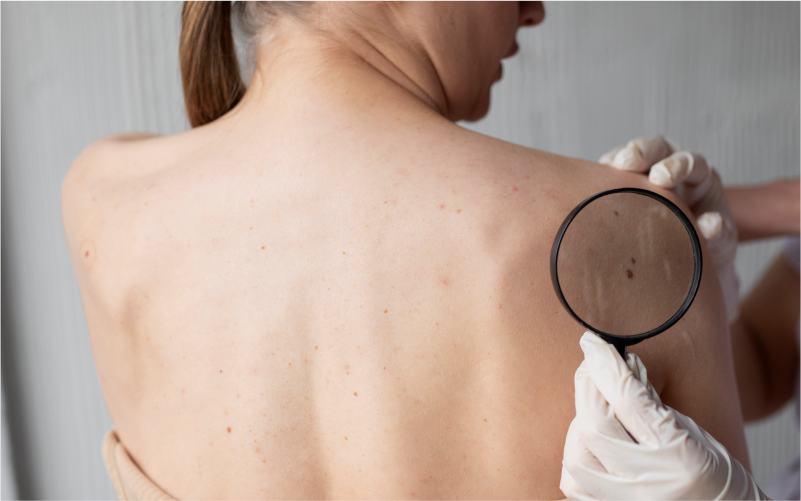Skin cancer
Skin cancer is a disease that involves the growth of abnormal cells in your skin tissues. Usually, as skin cells grow old and die, new cells form to replace them. When this process doesn’t work as it should — like after exposure to ultraviolet (UV) light from the sun — cells grow more quickly. These cells may be noncancerous (benign), which don’t spread or cause harm. Or they may be cancerous.
Skin cancer can spread to nearby tissue or other areas in your body if not caught early. Fortunately, most are cured if skin cancer is identified and treated in its early stages. So, you must talk with your healthcare provider if you have any signs of skin cancer.
There are three main types of skin cancer

Basal cell carcinoma
Basal cell carcinoma occurs under the basal cells in your epidermis (the outer layer of your skin).
Squamous cell carcinoma
Squamous cell carcinoma occurs in the squamous cells on the outer layer of your skin.
Melanoma
Melanoma, which forms in cells called melanocytes. Melanocytes produce melanin, a brown pigment that gives your skin its color and protects against some of the sun’s damaging UV rays. This is the most severe type of skin cancer because it can spread to other areas of your body.
Other types of skin cancer include:
- Kaposi sarcoma.
- Merkel cell carcinoma.
- Sebaceous gland carcinoma.
- Dermatofibrosarcoma protuberans.
Signs of skin cancer
Skin cancer looks different depending on what type of skin cancer you have. Thinking of the ABCDE rule tells you what signs to watch for:
- Asymmetry: Irregular shape.
- Border: Blurry or irregularly shaped edges.
- Color: Mole with more than one color.
- Diameter: Larger than a pencil eraser (6 millimeters).
- Evolution: Enlarging, changing in shape, color, or size. (This is the most critical sign.)
If you’re worried about a mole or another skin lesion, make an appointment and show it to your healthcare provider. They’ll check your skin and ask you to see a dermatologist to evaluate the lesion further.
The most common warning sign of skin cancer is a change on your skin — typically a new growth or a change in an existing growth or mole.
Skin cancer symptoms include:
- A new mole. Or a mole that changes in size, shape, or color or that bleeds.
- A pearly or waxy bump on your face, ears, or neck.
- A flat, pink/red- or brown-colored patch or bump.
- Areas on your skin that look like scars.
- Sores that look crusty have a depression in the middle or bleed often.
- A wound or sore that won’t heal or that heals but comes back again.
- A rough, scaly lesion that might itch, bleed and become crusty.
What does skin cancer look like?
Risk factors
- Previous sun exposure (UV light)
- Previous skin damage, such as burns or a significant scar
- Non-healing wounds and draining sinuses in persistent infection
- Actinic keratosis, a precancerous skin condition
Diagnosis of skin cancer
First, a dermatologist may ask you if you’ve noticed changes in any existing moles, freckles, or other skin spots or if you’ve noticed any new skin growths. Next, they’ll examine your skin, including your scalp, ears, palms of your hands, soles of your feet, between your toes, around your genitals, and between your buttocks.
What tests will be done to diagnose skin cancer?
If your provider suspects skin cancer, they may perform a biopsy. A tissue sample is removed in a biopsy and sent to a laboratory, where a pathologist examines it under a microscope. Your dermatologist will tell you if your skin lesion is skin cancer, what type you have, and discuss treatment options.
What are skin cancer stages?
Cancer stages tell you how much cancer is in your body. The locations of skin cancer range from stage 0 to stage IV. The higher the number, the more cancer has spread and the harder it is to treat. But melanoma staging differs from non-melanoma skin cancers that start in your basal or squamous cells.
Melanoma staging
Stage 0 (melanoma in situ): The melanoma is only in the top layer of your skin.
Stage I: The melanoma is low risk, and there’s no evidence that it has spread. It’s generally curable with surgery.
Stage II: Some features indicate that it’s likely to come back (recur), but there’s no evidence of spread.
Stage III: The melanoma has spread to nearby lymph nodes or nearby skin.
Stage IV: The melanoma has spread to more distant lymph nodes or skin or has spread to internal organs.
Non-melanoma staging
Stage 0: Cancer is only in the top layer of your skin.
Stage I (1): Cancer is in your skin’s top and middle layers.
Stage II (2): Cancer is in the top and middle layers of your skin and moves to target your nerves or more deep layers of skin.
Stage III (3): Cancer has spread beyond your skin to your lymph nodes.
Stage IIIV (4): Cancer has spread to other parts of your body and organs like your liver, lungs, or brain.
Treatment for skin cancer
Treatment depends on the stage of cancer. Sometimes, a biopsy alone can remove all the cancer tissue if it’s small and limited to the surface of your skin.
Other common skin cancer treatments, used alone or in combination, include:
Cryotherapy: Your dermatologist uses liquid nitrogen to freeze skin cancer. The dead cells slough off after treatment.
Excisional surgery: Your dermatologist removes the tumor and some surrounding healthy skin to be sure all the cancer is gone.
Mohs surgery: Your dermatologist removes only diseased tissue, saving as much surrounding normal tissue as possible. Providers use this to treat basal cell and squamous cell cancers and, sometimes, other skin cancers that develop near sensitive or cosmetically important areas, like your eyelids, ears, lips, forehead, scalp, fingers, or genital area.
Curettage and electrodesiccation: Your dermatologist uses an instrument with a sharp, looped edge to remove cancer cells as it scrapes across the tumor. Then, they use an electric needle to destroy any remaining cancer cells. Providers often use this to treat basal and squamous cell cancers and precancerous skin tumors.
Chemotherapy: Your dermatologist or oncologist uses medications to kill cancer cells. Anticancer medicines can be applied directly on the skin (topical chemotherapy) if limited to your skin’s top layer or provided through pills or an IV if cancer has spread to other parts of your body.
Immunotherapy: Your oncologist gives you medications to train your immune system to kill cancer cells.
Radiation therapy: Your oncologist uses radiation (intense energy beams) to kill or keep cancer cells from growing and dividing.
Photodynamic therapy: Your dermatologist coats your skin with medication, which they activate with a blue or red fluorescent light. This therapy destroys precancerous cells while leaving normal cells alone.
Side effects of the treatment
The side effects of skin cancer treatment depend on what treatments your healthcare provider think will work best for you. Chemotherapy for skin cancer can lead to nausea, vomiting, diarrhea, and hair loss. Other side effects or complications of skin cancer treatment include:
- Pain and swelling.
- Nerve damage that results in loss of feeling.
- Skin infection.
- Regrowth of the tumor after it’s been removed.
Can skin cancer be prevented?
In most cases, skin cancer can be prevented. The best way to protect yourself is to avoid too much sunlight and sunburn. UV rays from the sun damage your skin, and over time, this may lead to skin cancer.







